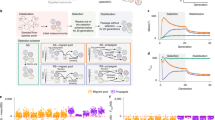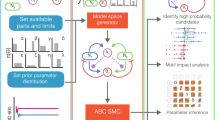Abstract
The functioning of natural microbial ecosystems is determined by biotic interactions, which are in turn influenced by abiotic environmental conditions. Direct experimental manipulation of such conditions can be used to purposefully drive ecosystems toward exhibiting desirable functions. When a set of environmental conditions can be manipulated to be present at a discrete number of levels, finding the right combination of conditions to obtain the optimal desired effect becomes a typical combinatorial optimisation problem. Genetic algorithms are a class of robust and flexible search and optimisation techniques from the field of computer science that may be very suitable for such a task. To verify this idea, datasets containing growth levels of the total microbial community of four different natural microbial ecosystems in response to all possible combinations of a set of five chemical supplements were obtained. Subsequently, the ability of a genetic algorithm to search this parameter space for combinations of supplements driving the microbial communities to high levels of growth was compared to that of a random search, a local search, and a hill-climbing algorithm, three intuitive alternative optimisation approaches. The results indicate that a genetic algorithm is very suitable for driving microbial ecosystems in desirable directions, which opens opportunities for both fundamental ecological research and industrial applications.


Similar content being viewed by others
Abbreviations
- EDTA:
-
Ethylenediaminetetraacetic acid
- GA:
-
Genetic algorithm
- LB:
-
Luria-Bertani
- OD:
-
Optical density
References
Bapat PM, Wangikar PP (2004) Optimization of rifamycin B fermentation in shake flasks via a machine-learning-based approach. Biotechnol Bioeng 86:201–208
Beste H, Fackeldey M, Willems M, Stockmann L, Weuster-Botz D (1997) Optimization of fermentation medium composition in substrate-controlled continuous stirred tank reactors. Chem Eng Technol 20:403–413
Boon N, Depuydt S, Verstraete W (2006) Evolutionary algorithms and flow cytometry to examine the parameters influencing transconjugant formation. FEMS Microbiol Ecol 55:17–27
Campbell R (1977) Microbial ecology. John Wiley & Sons, New York, NY
Davies ZS, Gilbert RJ, Merry RJ, Kell DB, Theodorou MK, Griffith GW (2000) Efficient improvement of silage additives by using genetic algorithms. Appl Environ Microbiol 66:1435–1443
Etschmann MMW, Sell D, Schrader J (2004) Medium optimization for the production of the aroma compound 2-phenylethanol using a genetic algorithm. J Mol Catal B-Enzym 29:187–193
Fang B, Chen H, Xie X, Wan N, Hu Z (2003) Using genetic algorithms coupling neural networks in a study of xylitol production: medium optimisation. Process Biochem 38:979–985
Forster C (2003) Wastewater treatment and technology Thomas Telford, London, UK
Gibson GR, Roberfroid MB (1995) Dietary modulation of the human colonic microbiota: Introducing the concept of prebiotics. J Nutr 125:1401–1412
Goldberg DE (1989) Genetic algorithms in search, optimization & machine learning Addison-Wesley, Reading, MA
Good PI (2000) Permutation tests: a practical guide to resampling methods for testing hypotheses Springer-Verlag, New York, NY
Holland JH (1975) Adaptation in natural and artificial systems: an introductory analysis with applications to biology control and artificial intelligence. University of Michigan Press, Ann Arbor, MI
King RB, Long GM, Sheldon JK (1998) Practical environmental bioremediation, the field guide. CRC Press, Boca Raton, FL
Marteijn RCL, Jurrius O, Dhont J, de Gooijer CD, Tramper J, Martens DE (2003) Optimization of a feed medium for fed-batch culture of insect cells using a genetic algorithm. Biotechnol Bioeng 81:269–278
Milavec P, Podgornik A, Štravs R, Koloini T (2002) Effect of experimental error on the efficiency of different optimization methods for bioprocess media optimization. Bioproc Biosyst Eng 25:69–78
Nagata Y, Chu KH (2003) Optimization of a fermentation medium using neural networks and genetic algorithms. Biotechnol Lett 25:1837–1842
Patil SV, Jayaraman VK, Kulkarni BD (2002) Optimization of media by evolutionary algorithms for production of polyols. Appl Biochem Biotechnol 102–103:119–128
Perneger TV (1998) What’s wrong with Bonferroni adjustments. BMJ 316:1236–1238
Pinchuk RJ, Brown WA, Hughes SM, Cooper DG (2000) Modeling of biological processes using self-cycling fermentation and genetic algorithms. Biotechnol Bioeng 67:19–24
Ponciano JM, Vandecasteele FP, Hess TF, Forney LJ, Crawford RL, Joyce P (2005) Use of stochastic models to assess the effect of environmental factors on microbial growth. Appl Environ Microbiol 71:2355–2364
Ranganath M, Renganathan S, Gokulnath C (1999) Identification of bioprocesses using genetic algorithm. Bioprocess Eng 21:123–127
Rocha M, Neves J, Rocha I, Ferreira EC (2004) Evolutionary algorithms for optimal control in fed-batch fermentation processes. Lect Notes Comput Sci 3005:84–93
Stolp H (1988) Microbial ecology: organisms, habitats, activities. Cambridge University Press, Cambridge, UK
Vandecasteele FPJ (2003) Constructing efficient microbial consortia using a genetic algorithm. In: Genetic and Evolutionary Computation Conference Workshop Program—Biological Applications for Genetic and Evolutionary Computation (BioGEC), pp 69–71
Vandecasteele FPJ, Hess TF, Crawford RL (2003) Constructing microbial consortia with optimal biomass production using a genetic algorithm. In: Genetic and Evolutionary Computation Conference—Late-Breaking Papers, pp 299–302
Vandecasteele FPJ, Hess TF, Crawford RL (2004a) Constructing microbial consortia with minimal growth using a genetic algorithm. Lect Notes Comput Sci 3005:123–129
Vandecasteele FPJ, Hess TF, Crawford RL (2004b) A correlated fitness landscape describes growth in experimental microbial ecosystems: Initial results. In: Genetic and Evolutionary Computation Conference—Late-Breaking Papers
Vandecasteele FPJ, Hess TF, Crawford RL (2004c) Thoughts on using evolutionary computation to assemble efficient ecosystems. In: Genetic and Evolutionary Computation Conference Workshop Proceedings—Biological Applications of Genetic and Evolutionary Computation (BioGEC)
Vandecasteele FPJ, Hess TF, Crawford RL (2007) Using genetic algorithms to optimize functions of microbial ecosystems. In: Hurst CJ, Crawford RL, Garland JL, Mills AL, Schmidt SK, Stetzenbach LD (eds) Manual of environmental microbiology, 3rd edn. ASM Press, Washington, DC (in press)
Weuster-Botz D, Karutz M, Joksch B, Schartges D, Wandrey C (1996) Integrated development of fermentation and downstream processing for l-isoleucine production with Corynebacterium glutamicum. Appl Microbiol Biotechnol 46:209–219
Weuster-Botz D, Kelle R, Frantzen M, Wandrey C (1997) Substrate controlled fed-batch production of l-lysine with Corynebacterium glutamicum. Biotechnol Progr 13:387–393
Weuster-Botz D, Pramatarova V, Spassov G, Wandrey C (1995) Use of a genetic algorithm in the development of a synthetic growth-medium for Arthrobacter simplex with high hydrocortisone delta(1)-dehydrogenase activity. J Chem Technol Biotechnol 64:386–392
Weuster-Botz D, Wandrey C (1995) Medium optimization by genetic algorithm for continuous production of formate dehydrogenase. Process Biochem 30:563–571
Žužek M, Friedrich J, Cestnik B, Karalic A, Cimerman A (1996) Optimization of fermentation medium by a modified method of genetic algorithms. Biotechnol Tech 10:991–996
Acknowledgements
We are grateful to Cornelia Sawatzky for critical revision of the manuscript. This research was supported by a fellowship from the Inland Northwest Research Alliance (INRA) Subsurface Science Research Institute, which is funded by the Department of Energy under contract DE-FG07-02ID14277.
Author information
Authors and Affiliations
Corresponding author
Rights and permissions
About this article
Cite this article
Vandecasteele, F.P.J., Hess, T.F. & Crawford, R.L. Demonstrating the suitability of genetic algorithms for driving microbial ecosystems in desirable directions. Antonie van Leeuwenhoek 92, 83–93 (2007). https://doi.org/10.1007/s10482-006-9138-y
Received:
Accepted:
Published:
Issue Date:
DOI: https://doi.org/10.1007/s10482-006-9138-y




